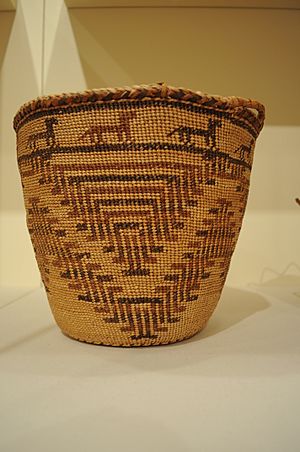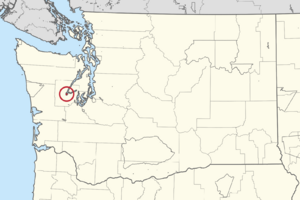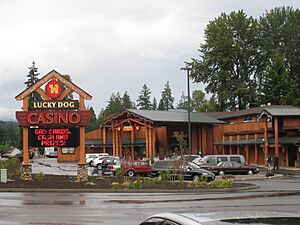Skokomish Indian Tribe facts for kids

Skokomish twined basket of red cedar bark, bear grass, cattail leaf, ca. 1890
|
|
| Total population | |
|---|---|
| 796 enrolled members | |
| Regions with significant populations | |
| Languages | |
| English, Twana | |
| Religion | |
| traditional tribal religion | |
| Related ethnic groups | |
| other Twana, Klallam, and Chimakum people |
The Skokomish Indian Tribe is a group of Native American people. They are also known as the Skokomish Tribal Nation. This tribe is made up of different groups, including Skokomish, Twana, Klallam, and Chimakum people.
They are a "federally recognized tribe." This means the United States government officially recognizes them as a sovereign nation. The Skokomish are part of the Southern Coast Salish people. These are native groups who have lived for a long time in the Pacific Northwest region of the United States, especially in Washington. The Skokomish are one of nine main groups, or "bands," of the Twana people.
The Skokomish Reservation
The Skokomish Tribe lives on the Skokomish Reservation. This special area is located in Mason County, Washington. It is just north of a town called Shelton, Washington.
The reservation was set up after a treaty was signed in 1855. A treaty is a formal agreement between different groups. After this treaty, some Klallam people also moved to the reservation.
Their Language
Most members of the Skokomish Tribe speak English today. The original language of the Skokomish people is called Skokomish. It is a type of Twana language, which belongs to the Central Salish language family.
Sadly, the last person who spoke Skokomish fluently passed away in 1980. However, efforts are often made to keep native languages alive.
How They Support Themselves
The Skokomish Tribe works to create ways for its members to earn a living. They have different businesses that help support the community.
For example, in 2015, the Skokomish Tribe bought the Glen Ayr resort. This resort is located near Hoodsport, Washington, along the Hood Canal. Owning businesses like this helps the tribe provide jobs and services for its people.



